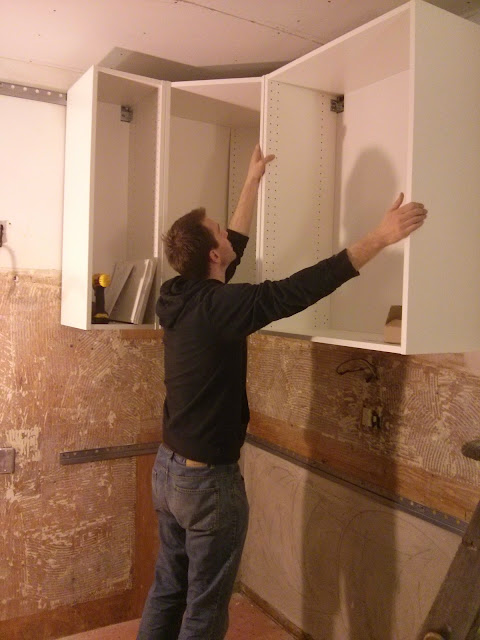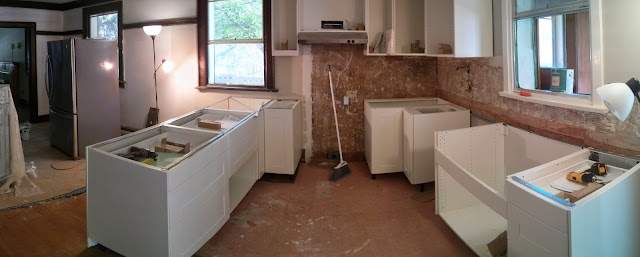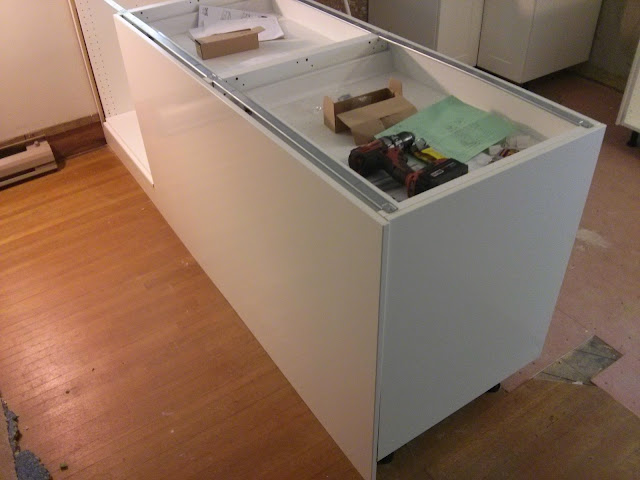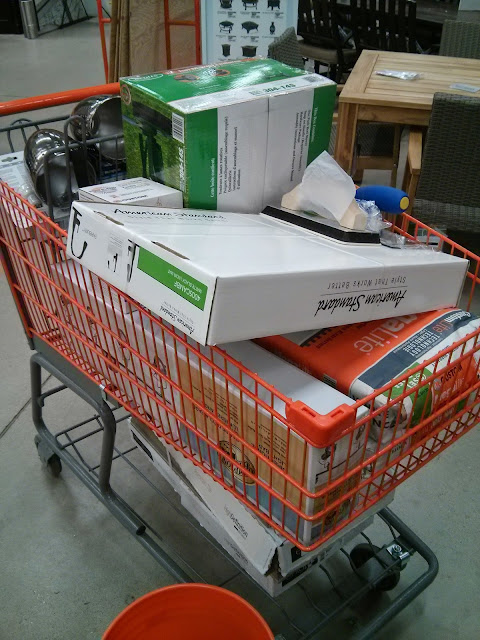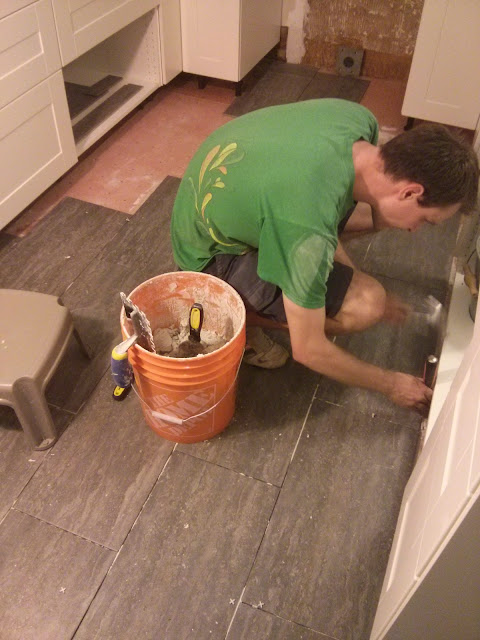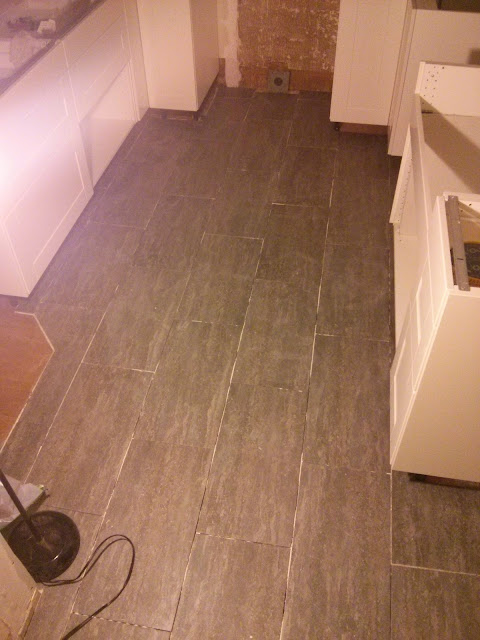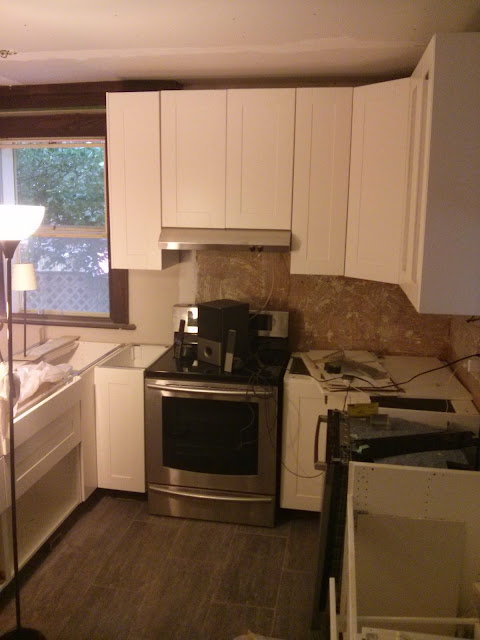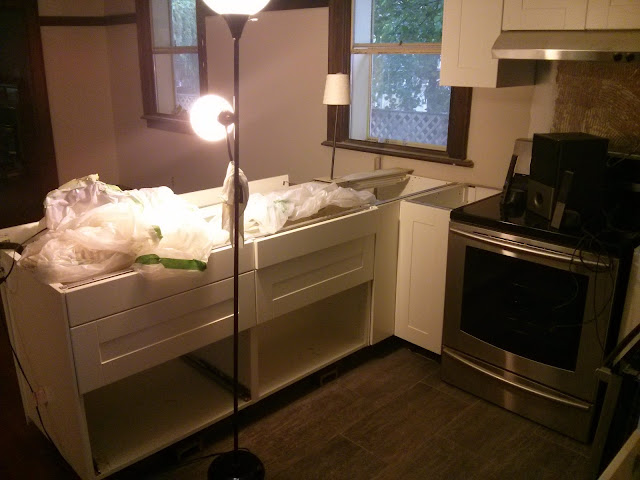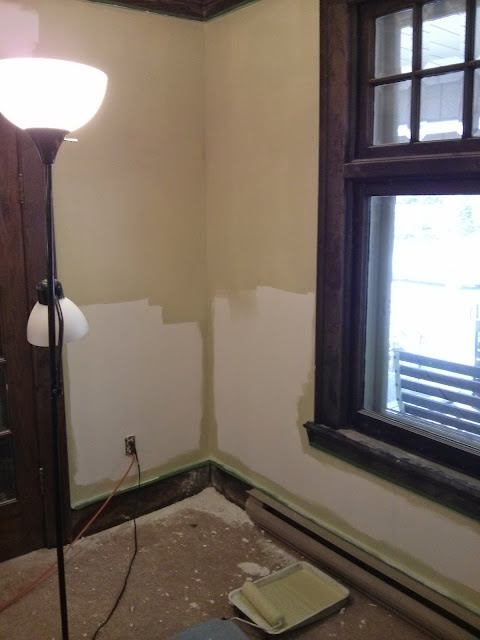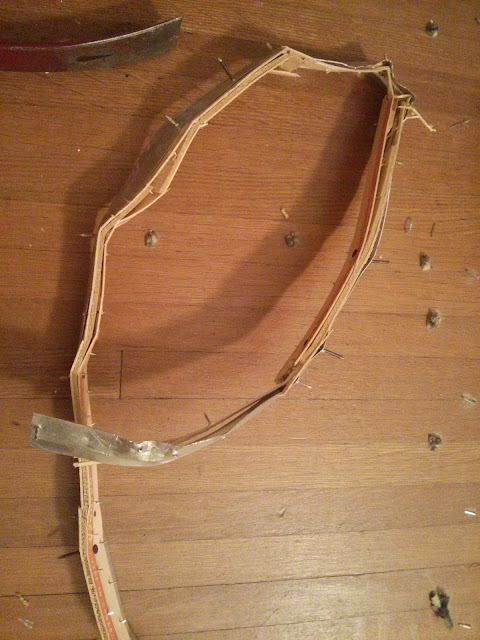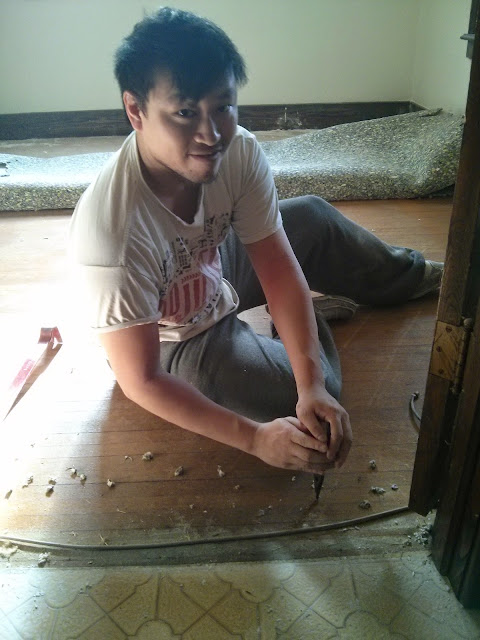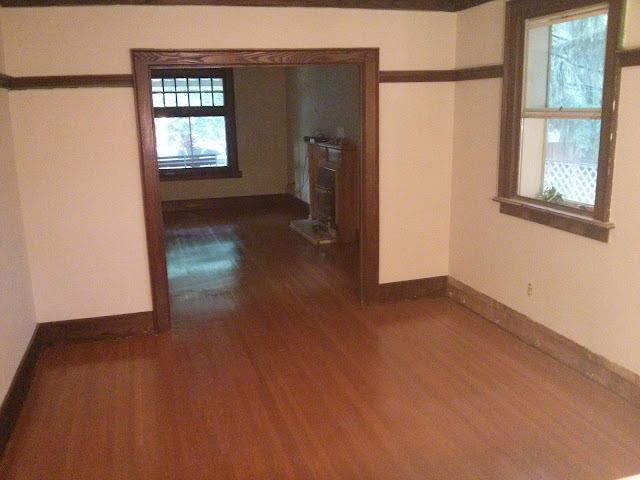Thank you, dear friends, for your kind words following my last post. We feel that the entire process of purchasing, renovating, and moving into this beautiful house has been very divinely guided. And we feel deeply, utterly blessed.
But you want to know all about the reno projects, right!?
I am SO PLEASED to tell you, that as of last night, we finished the last of our pre-move-in projects, and that now, the house is ready for us to move in!
(Dare I tell you how late we slept in this morning, to celebrate?)
It was a big final push, but we did it! Of course, with the help of our friends. As of two weeks ago, this was our final to-do list:
* Finish kitchen install
* Get countertops measured and installed
* Install tile on kitchen floor
* Pull up carpets in living and dining room
* Prime and paint dining room
* Refinish wood floors (patch, putty, sand, stain, lacquer, sand, polish!)
How about we walk through those projects one by one?
Kitchen Install
Remember those 77 boxes we had delivered from IKEA?
Two weeks ago, we had only built four or five of the “base” cabinets. Well, in the process of putting them together, I quickly realized that if I built them ALL before the kitchen was absolutely ready for us to install them, they would simply be in our way, gathering all sorts of dust and grime.
So once the kitchen was ready to have the cabinets installed, I went to work with my power drill and allen key!
Jordan hung the racks on the walls while I assembled the cabinets. IKEA’s kitchen installation is pretty slick, once you can figure out their instructions which are ALL IN PICTURES. No words, no descriptions, just line drawings of all the pieces with arrows. But once the racks are hung (those two horizontal, metal bars you see near the ceiling and again at hip height), you take the assembled base cabinet (no doors, shelves, or hinges yet) and hang them on the rack.
Once you have all the cabinets hung, you level them and then attach them to the wall and each other.
See the stainless steel range hood in the centre of the photo? To install that, Jordan had to make custom cutouts for the exhaust pipe, which you see as a dark rectangle in the cabinet directly above the hood.
We are going to have SO MUCH STORAGE! And So Much Counter Space!!!
I think our real pride of the kitchen design is our peninsula, which you see in the above photo on the very left, and here below:
There will be one cabinet unit with two doors facing the dining room, and two cabinet units with three drawers each facing the kitchen.
Don’t be deceived by this peninsula’s sleek appearance. It took Jordan the better part of a day to measure, cut, level, and attach the HUGE cover panel that faces the dining room. Because the back of the base cabinets are just raw particle board, IKEA had to sell us a 3′ x 8′ cover panel for this peninsula. (And you’d be surprised how much they can charge for a big piece of laminated plywood.) The real beauty of Jordan’s work here though, is the cut out for the cabinet doors at the left end of the peninsula – in the top left corner of the photo above. Notice that the cover panel is ONE PIECE and still goes all the way around the left side of where the cabinet doors will be installed? I’m proud of my man’s work.
Measure and Install Kitchen Counters
We had to push pretty hard to get the kitchen cabinets levelled and secured, because the countertop guy came at 7:00am on May 20 to measure everything. (I don’t have a picture because I was asleep while Jordan let the guy into the house.) Apparently, though, the countertop man set up a tripod in the centre of the kitchen, with a computer on it. He then had a digital “pen” attached to a long wire that fed into the computer. And he simply used the “pen” to touch each corner of every cabinet, and from that, the computer analyzed the angles and lengths and widths of the counter.
This is SCIENCE, people.
So now, the countertops will be installed THIS WEEK! On Wednesday! Then it will feel even more like a real kitchen!
We chose granite countertops for the kitchen, and they will be a dark grey (almost black), with flecks of silver and brown in them. I’ll post a photo once they’re in!
Tile the Kitchen Floor
Man, was THIS ever a steep learning curve project for us! There is a reason people get their tiling put in professionally. Not because pros can necessarily do a better or more perfect job, but because tiling was HARD.
Remember we finally got our subfloor secured and then our underlayer installed?
That plywood that we screwed into the subfloor was the smooth, mostly level surface we needed underneath our mortar and tile.
After borrowing a tile cutter from our friend Pete, we went to Home Depot and bought a LOT of supplies.
We spent a while in the tile aisle, but finally chose a large, light grey tile with white and light brown variegation to it, and chose a coloured grout to match called “New Taupe.” Because NO ONE has time for WHITE grout.
Our cart included four boxes of tile, two bags of mortar, a box of grout, a bucket, a grout float (the tool you apply grout with), and 1/8″ spacers. (In addition to lighting fixtures for our kitchen, a faucet for the kitchen sink, a push lawn-mower.)
The flooring guy at Home Depot recommended a certain kind of mortar (that also happened to be the most expensive mortar) that would be the easiest to work with and have the longest dry time for inexperienced tilers. But when we mixed it up, it was chalky, heavy, thick, and SUPER hard to work with.
After we measured and cut all the edge tiles, Jordan started tiling the kitchen floor on his own, but it was quickly evident that this would be a two-person job.
Being the Putty Princess, I went to work kneading and spreading the mortar into a smooth and level layer onto the underfloor. Jordan would then run the trowel over the mortar to create ridges. We used a 1/2″ trowel, which you see hanging on the edge of the bucket there. Then, with our 1/8″ spacers in place, we placed the tile and then press it into the mortar. And as we went along, we also had to use a damp sponge to clean up any extra mortar on the surface of the tile.
This was back-breaking, knee-busting, wrist-twisting work.
But after pushing through the evening without a dinner break, Team Klassen was finally victorious!
I texted this photo to my voice teacher around 10:30pm. She replied, “Beautiful. Now go to bed.”
So we did.
Once the mortar dried, the next evening we put our beautiful New Taupe grout into the grooves. Again, it was chalkier and drier than we’d expected. After trying to use the grout float to spread the grout (again, which the HD guy had sold to us as THE tool to use), we discovered that our gloved hands were far and above the most effective means of pushing the grout into the cracks, smoothing it, and removing the excess. Again, a quick wipe with a damp sponge to remove any extra grout.
But the grout box also instructed us that “after a two hour rest, remove the bloom with cheesecloth.” I quickly ran to the Valu-Mart down the street to pick up some cheesecloth. I arrived at the store at 8:57pm and I managed to grab a pack of cheesecloth as well as a box of raspberry popsicles before it closed at 9:00pm. And THEN, on my walk home, I found a pile of empty plastic plant pots on the curb outside the flower shop! Since they’d been thrown out with the trash, I helped myself to some. I even managed to grab a couple of hanging pots that I can put my spider plants in and hang on the front porch. But that’s for another post.
For two hours, we rested and watched a movie, and then wiped the tiles with cheesecloth to get rid of grout dust. Which makes you cough, so people, WEAR A MASK when you do it yourself.
24 hours later, we moved in our appliances!!!
This is starting to look like a REAL kitchen!
Living Room + Dining Room: Remove Carpet + Paint
After teaching ourselves to tile, it doesn’t seem terribly EXCITING to go back to painting and pulling up carpet, but I have to remind myself that, for most reasonable people, who plan to achieve reasonable amounts of work in a reasonable amount of time, painting a living room and dining room is a BIG TASK.
But we’re learning that we’re not reasonable people.
I think “ambitious people, who plan to achieve gargantuan amounts of work in an unreasonable amount of time” just about describes us. Don’t you?
A couple weeks ago, I painted the living room in a long morning’s work. I was done by 1pm for lunch break! We chose a colour called “Fernwood Glade” that is the most beautiful shade of green. It sets off our millwork (the wood trim) beautifully.
Then, in the work of a couple of evenings, our friend Tricia pulled up the carpet and padding.
Carpet is installed by putting a “tack strip” around the edge of the room. This is a narrow strip of wood, with small nails pointing upwards, to grab the carpet. This tack strip is nailed into the floor to hold things in place. But under the carpet, is the padding, which, in our house, was simply STAPLED right. into. the. hardwood. floors.
So the process of removing carpet is this:
* Pry up a corner or edge of carpet from the tack strip.
* Fold back a 3-4′ width of carpet the entire width of the room. Use a box cutter to cut the carpet along the fold.
* Do the same with the padding underneath.
* Roll up this 3-4′ width into a roll, and tie with string or wrap with duct tape. This carpet gets either put on the curb for pick up, or, if you have as much as we do, cart it to the dump.
* Then, remove the tack strip around the edge of the room with a crowbar, hammer, pliers, and LOTS of patience and fear of getting poked by all those nails. Here’s a photo of the tack strip around our fireplace, which was ALSO reenforced by a METAL strip. Talk about a torture device.
* And finally, the tedious work of extracting Every. Single. Staple. from the floor. Remember our friend Dan, of infinite patience and limitless good cheer?
Each of those tiny tufts on the ground in front of Dan is a staple with a small bit of the padding still attached.
Once all the carpet in the living room was out, I had to paint the dining room before we could pull the carpet up in there.
This is the point where I admit that I injured my right wrist after a day spent in the garden pulling out weeds and turning the soil so I could put in my veggies. I made Jordan promise me an afternoon in the garden once the countertops were measured, and he delivered, yet again! (Did I tell you this guy is my HERO!?) I was SO pleased. But I’ll do a separate post about our garden.
The next day, however, I woke up unable to turn or bend my right wrist without pain. HOW FRUSTRATING! Let’s just say I spent a couple days with a tensor bandage, an ice pack, a hot pack, some ibuprofen, and some Voltaren gel, recommended by our doctor friend Ian.
In the meantime, though, I just had to paint the dining room. With my left hand.
It was slow, but I was very happy with how it turned out.
Then a quick removal of the dining room carpet (again, thanks to Mister Dan), and we were ready to refinish the floors!
Refinishing Our Original Hardwood Floors
(patch, putty, sand, stain, lacquer, sand, polish!)
Oh my. I think I need to stop this post right here, because 1) it’s already too long, and 2) talking about refinishing the floors really deserves its own post.
In the meantime, think of us as we pack up our old apartment this week! There will be lots of cleaning this week as well – cleaning up the reno mess at No. 77 so it’s actually livable, and then a post-move-out clean at the old apartment so we can hand over the keys on Sunday.
THIS IS HAPPENING, folks.
UP NEXT: The long-awaited post about our beautiful, shiny, hardwood floors! Including disappointment, frustration, good friends, and finally, a sock-party on our slick new floors.
